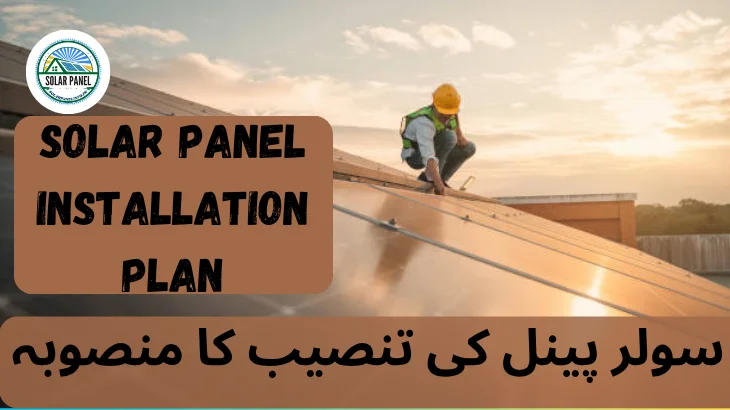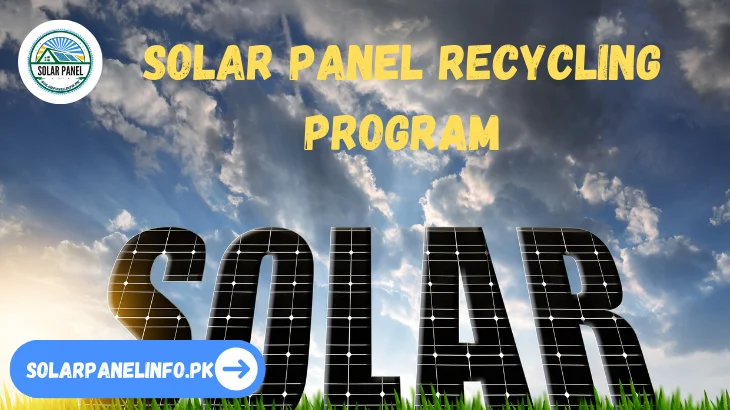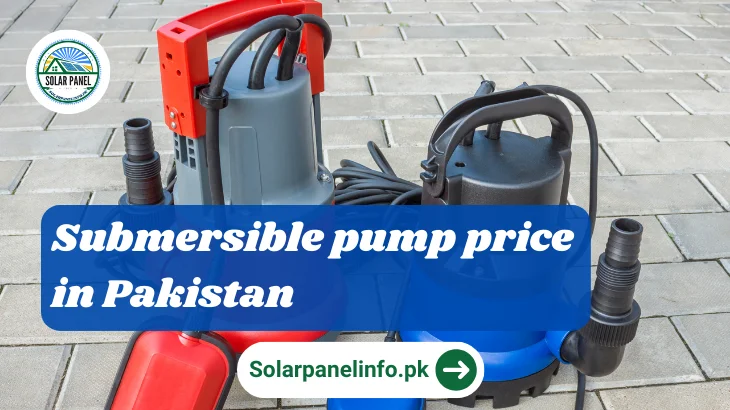Solar Panel Installation Plan
The worldwide shift toward sustainable energy sources has resulted in a significant rise in the use of solar panels. With individuals, businesses, and governments striving to lower carbon emissions and reduce energy expenses, solar energy is an effective and environmentally friendly option. Nevertheless, the process of installing solar panels may appear both complicated and costly. Luckily, solar panel installation plans, which include financing solutions, incentives, and detailed installation steps, make this undertaking more manageable. In this article, we will discuss the key elements of a solar panel installation plan, aiding you in understanding what to anticipate and how to make informed decisions. Here we will discuss the Solar panel installation Plan.
Read more: How to fit a Solar Panel.

ئیدار توانائی کے ذرائع کی طرف دنیا بھر میں تبدیلی کے نتیجے میں سولر پینلز کے استعمال میں نمایاں اضافہ ہوا ہے۔ افراد، کاروبار اور حکومتیں کاربن کے اخراج کو کم کرنے اور توانائی کے اخراجات کو کم کرنے کے لیے کوشاں ہیں، شمسی توانائی ایک موثر اور ماحول دوست آپشن ہے۔ اس کے باوجود، سولر پینلز کی تنصیب کا عمل پیچیدہ اور مہنگا دونوں ظاہر ہو سکتا ہے۔ خوش قسمتی سے، سولر پینل کی تنصیب کے منصوبے، جن میں مالیاتی حل، مراعات اور تنصیب کے تفصیلی اقدامات شامل ہیں، اس اقدام کو مزید قابل انتظام بناتے ہیں۔ اس مضمون میں، ہم شمسی پینل کی تنصیب کے منصوبے کے کلیدی عناصر پر تبادلہ خیال کریں گے، جس سے آپ کو یہ سمجھنے میں مدد ملے گی کہ کیا توقع کرنی ہے اور باخبر فیصلے کیسے کیے جائیں۔
Understanding Solar Panel Installation
Installing solar panels involves installing photovoltaic (PV) systems on your property to capture and convert sunlight into electricity. This process includes not only the solar panels themselves but also essential equipment such as inverters, mounting systems, and wiring.
Key Components:
Solar Panels:(سولر پینلز)
Comprising photovoltaic cells, solar panels are designed to capture sunlight and convert it into usable electricity.
Inverter:(انورٹر)
The inverter’s primary function is to transform the direct current (DC) electricity generated by the solar panels into alternating current (AC) electricity, which is the standard power used in residential settings.
Mounting System:(ماؤنٹنگ سسٹم)
These systems are essential for securely holding solar panels in place, whether on a rooftop or the ground, ensuring stability and optimal exposure to sunlight.
Wiring and Electrical Systems:(وائرنگ اور برقی نظام:)
This crucial infrastructure connects the solar panels to the inverter and ultimately links the entire system to your home’s electrical grid, facilitating the effective distribution of electricity.
Determining the Right Size and Type of Solar System
Before initiating a solar panel installation, it is crucial to assess both your energy consumption and the available space for the panels. Several factors will influence the size of the solar panel system you need:
Energy Consumption:(توانائی کی کھپت)
Begin by calculating your monthly or annual electricity usage, which will help determine the energy your solar system should generate. This information is typically available on your electricity bill.
Roof Space:(چھت کی جگہ)
The amount of space on your roof or property will dictate how many solar panels can be installed. Keep in mind that larger systems necessitate more space.
Solar Efficiency:(شمسی توانائی کی کارکردگی)
Efficiency varies among different solar panel models. Some panels can generate more electricity in a smaller area, affecting both the overall cost and performance of your solar system. Carefully evaluating these factors will help ensure a successful solar energy installation that meets your needs.
Financing Options for Solar Panel Installation
One significant barrier to investing in solar panels is the initial upfront cost. However, there are several financing options available that can make solar panel installation more affordable for homeowners.
Solar Loans(سولر لون)
Solar loans are a popular financing option that allows homeowners to spread the cost of their solar panel system over time, typically within a range of 5 to 20 years. These loans may be secured, meaning they require collateral, or unsecured, which does not necessitate any collateral.
Solar Leases and Power Purchase Agreements (PPAs) (سولر لیز اور پاور پرچیز ایگریمنٹس)
With a solar lease or a Power Purchase Agreement (PPA), homeowners can utilize a solar system installed on their property without the upfront costs. In this arrangement, the homeowner pays a fixed monthly fee to use the system. While they do not own the solar panels, they benefit from the reduced electricity bills. In the case of a PPA, the homeowner agrees to buy the electricity generated by the system at a set price.
Cash Purchase (نقد خریداری)
Opting for a cash purchase of solar panels is the most direct method of financing the installation. Though this requires a substantial initial investment, it often results in significant long-term savings without the worry of monthly payments.
Incentives and Rebates(مراعات اور چھوٹ)
Many local and federal governments, as well as utility companies, provide various incentives for solar panel installations. In the U.S., homeowners can take advantage of the federal Investment Tax Credit (ITC), which allows for a tax credit of up to 30% of the installation costs. Additional local and state incentives may also be available, further lowering the overall expense.
Choosing the Right Solar Installer(صحیح سولر انسٹالر کا انتخاب)
The effectiveness of a solar panel installation is heavily influenced by the installer’s expertise. Therefore, selecting a reputable and experienced solar installation company is essential for ensuring that the system is installed properly and operates efficiently.
Factors to consider when choosing a solar installer:
Certifications and Licensing:(سرٹیفیکیشن اور لائسنسنگ)
Ensure that the installer has the necessary certifications (such as NABCEP in the U.S.) and holds the licenses required by local regulations.
Experience:(تجربہ)
Select a company that has a proven track record in solar installations. Be sure to check reviews, testimonials, and case studies of their past projects.
Warranty and Support:(وارنٹی اور سپورٹ)
Confirm that the installer offers a warranty for both the solar panels and the installation process. Good after-sales support is crucial for maintenance and troubleshooting.
Pricing:(قیمتوں کا تعین)
Obtain quotes from multiple installers and compare their pricing. This will help ensure you receive good value for your money without sacrificing quality.
Installation Process
Once you have selected an installer and secured financing for your solar system, the installation process can begin. Below is a detailed outline of the typical steps involved:
Step 1: Site Evaluation(سائٹ کی تشخیص)
The process starts with an installer visiting your property to conduct a comprehensive assessment. They will examine the condition of your roof, its orientation, and its angle to determine optimal solar panel placement. Additionally, they will analyze your energy requirements and assess how much sunlight your roof receives throughout the day.
Step 2: Design and Permits(ڈیزائن اور اجازت نام)
After the site evaluation, the installer will design a custom solar system tailored to your property’s unique needs. Subsequently, they will handle the necessary paperwork to obtain permits and schedule inspections, which are essential for complying with local regulations.
Step 3: System Installation(سسٹم کی تنصیب)
Once the permits are secured, the installation team will begin the process of mounting the solar panels, installing the inverter, and completing the required wiring. This phase generally takes between one to three days, depending on the complexity of your system.
Step 4: Inspection and Connection(معائنہ اور کنکشن)
Following installation, local authorities will inspect to ensure that the system adheres to safety and code requirements. Once it passes inspection, the installer will connect the solar system to your home’s electrical grid.
Step 5: Monitoring and Maintenance (نگرانی اور دیکھ بھال)
Most solar systems are equipped with monitoring tools that enable you to track their performance, either through a mobile app or a website. To ensure the system operates efficiently, regular maintenance is required, which includes cleaning the panels and checking for any signs of wear and tear.
Benefits of Solar Panel Installation
Cost Savings:(لاگت کی بچت)
Installing solar panels can lead to significant reductions in electricity bills, with some homeowners achieving complete elimination of their energy costs.
Energy Independence:(توانائی کی آزادی)
Generating your electricity through solar power reduces dependence on the utility grid, providing a safeguard against rising energy prices and potential power outages.
Environmental Impact:(ماحولیاتی اثرات)
Solar energy is a clean and renewable resource. Transitioning to solar not only minimizes your carbon footprint but also supports broader efforts toward environmental sustainability.
Increase in Property Value:(جائیداد کی قیمت میں اضافہ)
Homes equipped with solar panels often experience an increase in market value, making solar energy an attractive long-term investment.
Considerations and Challenges
While solar panels provide a range of advantages, it’s essential to consider a few important factors:
Weather Dependency:(موسم کا انحصار)
The efficiency of solar energy generation is closely tied to sunlight availability. As a result, cloudy or rainy days can diminish overall energy production.
Upfront Costs:(پیشگی اخراجات)
Despite various financing options available, the initial investment for solar panel systems can still pose a financial challenge for many homeowners.
Roof Suitability:(چھت کی مناسبیت)
Not every roof is conducive to solar panel installation. Factors such as shading, size, and the condition of the roof can significantly impact the feasibility of adding a solar system.
Conclusion
The installation of solar panels presents several advantages, such as long-term savings, energy autonomy, ecological sustainability, and a boost in property value. As the interest in renewable energy grows, solar power is becoming increasingly accessible due to various financing options, government solar schemes, incentives, and expert installation services. By comprehending the essential elements of a solar panel installation strategy and thoughtfully evaluating factors like energy usage, financing, and selecting the right installer, homeowners can make well-informed choices and reap the benefits of solar energy. Although there are obstacles to consider, including reliance on weather conditions and initial expenses, the overall advantages render solar power a valuable investment for a sustainable future. Here we will discuss the Solar Panel Installation Plan.
سولر پینلز کی تنصیب کئی فوائد پیش کرتی ہے، جیسے طویل مدتی بچت، توانائی کی خود مختاری، ماحولیاتی پائیداری، اور جائیداد کی قیمت میں اضافہ۔ جیسے جیسے قابل تجدید توانائی میں دلچسپی بڑھ رہی ہے، مختلف مالیاتی اختیارات، حکومتی ترغیبات، اور ماہرین کی تنصیب کی خدمات کی وجہ سے شمسی توانائی تیزی سے قابل رسائی ہوتی جا رہی ہے۔ سولر پینل کی تنصیب کی حکمت عملی کے ضروری عناصر کو سمجھ کر اور توانائی کے استعمال، فنانسنگ، اور صحیح انسٹالر کو منتخب کرنے جیسے عوامل کا سوچ سمجھ کر جائزہ لے کر، گھر کے مالکان اچھی طرح سے باخبر انتخاب کر سکتے ہیں اور شمسی توانائی کے فوائد حاصل کر سکتے ہیں۔ اگرچہ غور کرنے کے لیے رکاوٹیں ہیں، بشمول موسمی حالات اور ابتدائی اخراجات پر انحصار، مجموعی فوائد شمسی توانائی کو پائیدار مستقبل کے لیے ایک قیمتی سرمایہ کاری فراہم کرتے ہیں۔
FAQ’s
How long does the solar panel installation process take?
Solar Panel Installation Plan usually requires 1 to 3 days, depending on system complexity.
Will I still have electricity on cloudy days or at night?
Yes, solar systems are equipped with batteries or are connected to the grid, allowing you to access electricity when solar generation is low.
How much can I save on my electricity bill with solar panels?
Savings can significantly vary, but many homeowners have the potential to reduce their electricity bills by 50% to 100%, depending on their system size and energy consumption.


